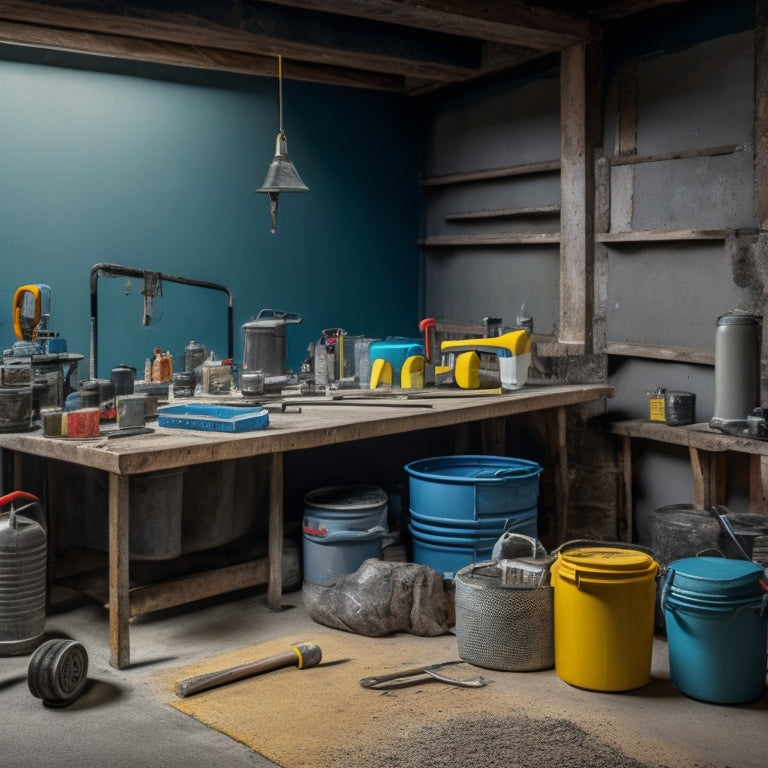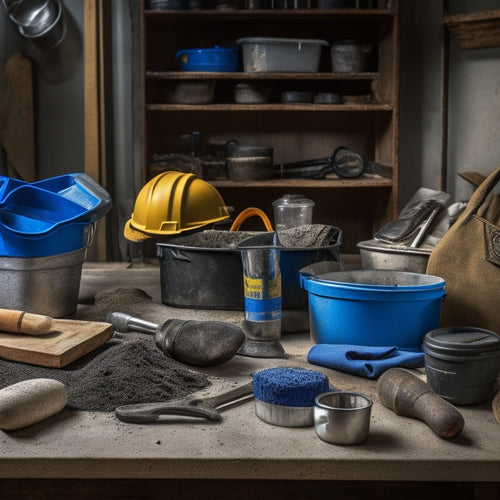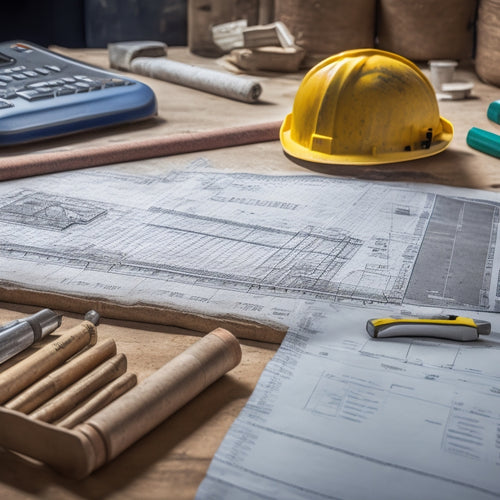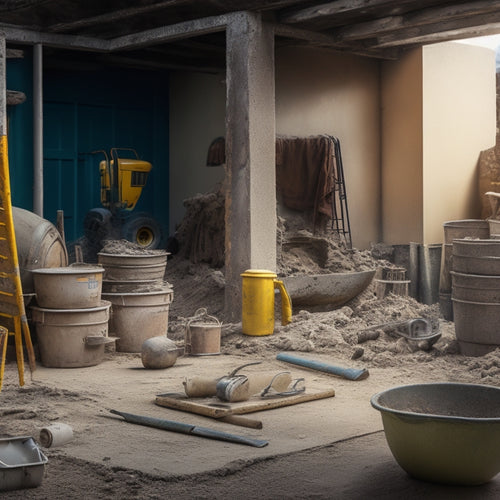
7 Must-Have Tools for Concrete Sealing Success
Share
When it comes to concrete sealing, you'll need the right tools to guarantee success. You'll require a pressure washer for thorough surface preparation, concrete sealer application tools like lambswool applicators and roller extension poles, and sealant-specific sprayer nozzles for proper spray patterns. A cleaning solution and brush combo will help with surface prep, while temperature and humidity gauges will guarantee ideal environmental conditions. Don't forget protective gear like safety goggles and respirator masks, and measuring and mixing buckets for accurate sealant preparation. With these 7 must-have tools, you'll be well on your way to achieving a professional-grade finish - and that's just the starting point for a truly successful project.
Key Takeaways
• A pressure washer with adjustable pressure settings and various nozzle options is essential for thorough surface preparation before sealing.
• Lambswool and microfiber applicators are necessary for even coat distribution on smooth and textured surfaces, respectively.
• Sealant-specific sprayer nozzles, such as fan, cone, and flood nozzles, ensure proper spray pattern and flow rate for optimal results.
• Temperature and humidity gauges are crucial for monitoring environmental conditions to prevent poor adhesion and uneven finishes.
• Measuring and mixing buckets, along with reliable mixing tools, are vital for achieving accurate proportions and consistent blends of sealant components.
Pressure Washer for Surface Prep
You'll typically use a pressure washer to thoroughly clean the concrete surface before sealing, as this vital step removes dirt, grime, and old sealers that can interfere with the new sealant's adhesion.
When selecting a pressure washer, consider the surface cleaning techniques you'll need to employ. Look for a model with adjustable pressure settings to accommodate varying levels of dirt and grime. Additionally, choose a washer with a wide range of nozzle options to guarantee you can reach all areas of the surface.
Regular pressure washer maintenance is essential to guarantee peak performance and extend the life of your equipment. Check and replace worn-out nozzles, and clean or replace filters as needed. It's also important to store your pressure washer in a dry, protected area to prevent rust and corrosion.
Concrete Sealer Application Tools
Selecting the right concrete sealer application tools is essential to achieving a uniform, even coat and confirming the sealant adheres properly to the prepared surface. You'll want to choose tools that suit the specific concrete surface textures you're working with, as well as the type of sealant you're applying.
Here are some must-have tools to add to your arsenal:
-
Lambswool applicators: Ideal for smooth surfaces, these applicators provide an even, consistent coat.
-
Microfiber applicators: Great for textured surfaces, microfiber applicators help the sealant penetrate deeper into the concrete.
-
Roller extension poles: Perfect for large areas, these poles allow you to apply sealant quickly and efficiently.
-
Brushes: Useful for applying sealant to small, intricate areas or edges.
-
Notched squeegees: Help remove excess sealant and achieve a smooth finish.
Remember to perform sealant compatibility testing on a small, inconspicuous area before applying it to the entire surface. This confirms the sealant adheres properly and doesn't react negatively with the concrete.
Sealant-Specific Sprayer Nozzles Needed
When applying concrete sealers with a sprayer, it's important to use sealant-specific nozzles to achieve the ideal spray pattern, flow rate, and atomization for your particular sealant. You can't just grab any nozzle and expect the best results.
Sealant compatibility is vital, as different nozzles are designed to work with specific sealant types. Using the wrong nozzle can lead to uneven coverage, wasted material, and subpar performance.
You'll need to choose from various nozzle types, including fan nozzles, cone nozzles, and flood nozzles. Fan nozzles are ideal for acrylic and polyurethane-based sealers, while cone nozzles work best with silane and siloxane-based sealers. Flood nozzles are perfect for large areas and high-flow applications.
Consider the viscosity, surface tension, and flow rate of your sealant when selecting the right nozzle. Remember, the wrong nozzle can compromise your entire sealing project.
Take the time to choose the correct sealant-specific nozzle to guarantee a successful, high-quality seal.
Cleaning Solution and Brush Combo
Before applying a concrete sealer, a thorough cleaning of the surface is essential, and that's where a high-quality cleaning solution and brush combo come into play. You can't skip this step, as even the slightest dirt and grime can compromise the sealer's adhesion and effectiveness.
When selecting a cleaning solution, opt for one specifically designed for concrete. These solutions are formulated to break down dirt and grime without damaging the concrete. Pair this with the right brush type, and you'll be amazed at how easily dirt and stains are removed.
Here are some key considerations for your cleaning solution and brush combo:
-
Choose a cleaning solution that's biodegradable and environmentally friendly.
-
Select a brush with stiff bristles for heavy-duty cleaning or soft bristles for more delicate surfaces.
-
Consider using a brush with an adjustable handle for hard-to-reach areas.
-
Always follow the manufacturer's instructions for cleaning techniques and solution dilution.
-
Test the cleaning solution on a small, inconspicuous area before applying it to the entire surface.
Temperature and Humidity Gauges
You'll need to accurately measure the ambient temperature and humidity levels to guarantee ideal concrete sealer application, and that's where temperature and humidity gauges come into play.
These gauges are vital in ensuring the concrete sealer adheres properly to the surface, as incorrect temperatures and humidity levels can lead to poor adhesion, uneven finishes, or even sealer failure.
Temperature fluctuations can greatly impact the sealer's performance, so it's important to monitor temperatures within the recommended range for the specific sealer you're using.
Meanwhile, humidity effects can cause the sealer to dry too quickly or slowly, affecting its overall performance.
Protective Gear for Safety First
As you prepare to apply the concrete sealer, don't overlook the importance of wearing protective gear to safeguard yourself from potential health risks and injuries.
Concrete sealing can involve working with harsh chemicals, abrasive materials, and heavy equipment, which can be hazardous if you're not properly protected.
To guarantee your safety, make sure you have the following essential protective gear:
-
Safety goggles: Protect your eyes from chemical splashes, dust, and debris with high-quality goggles that provide excellent optical clarity.
-
Protective gloves: Wear chemical-resistant gloves that fit comfortably and provide grip to prevent slipping and falling.
-
Respirator mask: Breathe easy with a mask that filters out dust, fumes, and other airborne particles.
-
Steel-toed boots: Safeguard your feet from heavy objects and equipment with sturdy boots that meet industry standards.
-
Long-sleeved clothing and pants: Cover your skin with durable, breathable clothing that prevents skin contact with chemicals and abrasives.
Measuring and Mixing Buckets Essential
When you're preparing to seal concrete, you'll need to guarantee you have the right measuring and mixing tools to get the job done accurately and efficiently.
You're not just mixing concrete; you're creating a chemical reaction that requires precise measurements to achieve the desired results.
Accurate Measurement Matters
Precise measurements are critical to achieving the perfect seal, and that's where measuring and mixing buckets come into play. As a concrete sealer, you understand the importance of accurate measurement techniques to guarantee a successful project. To get it right, you need the right measurement tools.
Here are some must-haves for accurate measurement:
-
Measurement scales: Digital or mechanical scales that can accurately measure small increments of weight or volume.
-
Graduated mixing buckets: Buckets with clear markings for measuring and mixing the right proportions of sealant and solvent.
-
Measuring cups: Accurate, easy-to-read cups for measuring small amounts of additives or solvents.
-
Calibrated measuring devices: Devices that guarantee precise measurement of viscosity, temperature, and other critical factors.
-
Conversion charts and calculators: Tools that help you quickly convert between units of measurement and calculate the right ratios.
Efficient Mixing Essentials
You'll need reliable mixing tools to combine your accurately measured components, and that's where measuring and mixing buckets come into play. These essential tools guarantee consistent results by allowing you to accurately mix and blend your sealant components.
A sturdy, high-quality mixing bucket is important for successful concrete sealing projects. It's essential to choose a bucket that's specifically designed for mixing sealants, as it will provide the necessary strength and durability to handle the mixing process.
When it comes to mixing techniques, a measuring and mixing bucket will help you achieve the perfect sealant consistency. By following the manufacturer's instructions and using the right mixing tools, you'll be able to create a uniform blend that's free of lumps and air pockets.
This is significant, as inconsistent mixing can lead to subpar results and compromised sealant performance. With the right measuring and mixing buckets, you'll be able to master the art of mixing and achieve professional-grade results that will leave your concrete surfaces looking like new.
Frequently Asked Questions
Can I Use a Regular Garden Hose for Surface Preparation?
When it comes to surface cleaning, you might think a regular garden hose will do the trick, but think again.
While it may seem convenient, a garden hose often lacks the necessary pressure and flow rate to effectively remove dirt and debris.
Instead, consider hose alternatives like a pressure washer or a dedicated surface preparation tool, which will give you the power and precision you need to get the job done right.
How Do I Know Which Sealer Type Is Best for My Concrete Project?
'Oh, you thought picking a sealer was as easy as choosing a favorite pizza topping? Think again! You're about to plunge into a world of complexity.
To determine the best sealer for your project, you'll need to evaluate sealer compatibility with your concrete's porosity, moisture levels, and exposure to sunlight.
Identify your project requirements, including the desired finish, durability, and maintenance needs.
Don't worry, it's not rocket science... but close.'
What Is the Ideal Temperature for Applying Concrete Sealer?
When you're preparing to apply a concrete sealer, timing is essential. You want to guarantee the ideal temperature for application.
Typically, it's between 50°F and 90°F (10°C and 32°C). If it's too hot, the sealer can evaporate too quickly, and if it's too cold, it may not penetrate properly.
You'll want to avoid temperature extremes, as they can negatively impact the sealer's performance and longevity. By applying within this temperature range, you'll get the best results and a successful seal.
Can I Apply Concrete Sealer in Direct Sunlight?
When you're about to apply concrete sealer, you're probably wondering if direct sunlight is a good idea.
Here's the deal: direct sunlight can negatively impact the sealing process. The sunlight effects can cause the sealer to evaporate too quickly, leading to uneven application and a poor finish.
Instead, try to apply the sealer in the shade or on a cloudy day. This will allow you to master the application techniques and achieve a smooth, professional-looking finish.
How Often Should I Reapply Concrete Sealer for Optimal Protection?
Did you know that 75% of concrete sealers fail prematurely due to inadequate reapplication?
You're wise to ask how often to reapply for ideal protection. The sealer lifespan depends on factors like foot traffic, climate, and cleaning frequency.
As a general rule, you should reapply every 1-3 years, depending on the sealer type and application frequency.
Keep in mind that some sealers may require more frequent reapplication, so always follow the manufacturer's guidelines.
Conclusion
You've got the skills, now it's time to seal the deal!
With these 7 must-have tools in your arsenal, you'll be well on your way to concrete sealing success.
Remember, a smooth operation is all about having the right gear and using it wisely.
Don't get caught off guard - be prepared for any situation and your work will be the 'cream of the crop'.
By investing in these essentials, you'll be ensuring a job well done and a reputation that's rock-solid.
Related Posts
-

5 Tools Needed for Quick Fix Concrete Mixing
You'll need five essential tools to tackle a quick fix concrete mixing project efficiently. First, you'll require a s...
-

5 Tips for Accurate Concrete Measurement Tools
To guarantee accurate concrete measurement, you'll want to calibrate your measuring tools regularly, choosing a frequ...
-

What Tools Are Needed for Concrete Wall Foundations
You'll need a thorough array of tools and equipment to construct a concrete wall foundation that meets structural int...


